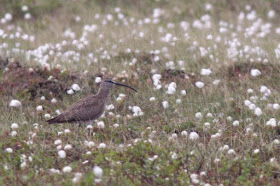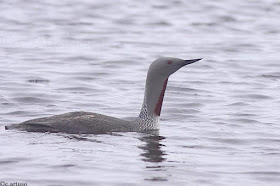Moving away from the treeline into the open
tundra brings with it a lot of excitement for those of us who live in the south
and don’t get to see tundra birds in their breeding habitat very often. Of
course, one has to come prepared for the bugs, which can be absolutely
horrendous up here… you get a SMALL sense of this in the photo below where I
forgot to fan the air before taking a habitat shot…
(and that’s just the ones around the camera – there were
many, many more around me!)
After wading through the numerous floating sphagnum bogs of
the central boreal forest for much of June, the tundra offered the relief of
walking across more open country
and I
was greatly looking forward to that. However, it was not all easy as,
especially around Seal River, I encountered many large willow swales that had
to be negotiated, including a lot of weaving and swimming through the dense
branches. After getting cut up and my clothing ripped I eventually lost a few
toques and a mosquito jacket thanks to those willows. So much for easy walking!
The other promise of easy walking that the tundra offers is embodied in the
word “permafrost” – even when traveling through the dens of the Hudson Bay
lowlands, you never sink to the same extent that you do in the boreal biome
because usually the ground is permanently frozen justa
few feet below the surface (although in
reality the permafrost is not evenly distributed). As anyone who has read
anything about global climate change will know, changes to the permafrost are
occurring across the north and could have huge knock-on impacts for wildlife
and humans alike. Around the Seal River, I found several places where the
permafrost was exposed, such as seen in the photo below where a chunk of soil
and debris had broken off.

One of the biggest pieces of news from the Manitoba Breeding
Bird Atlas (
www.birdatlas.mb.ca)
summer season was confirming
Long-tailed Jaeger as a breeding species in the
province for the very first time. Ken De Smet and Joel Kayer found a nest at
Nejanilini Lake and I found three pairs near Schmock Lake. These are both
inland tundra sites as opposed to the much more visited coastal tundra sites
and could explain why they have flown under the radar for so long. As
Long-tailed Jaeger are said to be less kleptoparasitic (steal food from other
birds such as gulls and terns by forcing them to regurgitate their catch) than
the Parasitic Jaeger that breeds regularly in Manitoba’s coastal tundra, they
may be more confined to inland tundra away from the larger and heavier
Parasitic Jaegers and where they can capitalize on lemmings and such. Having
said that, there was no real evidence of a lemming peak in northern Manitoba
this year and other lemming opportunists like Snowy Owls and Rough-legged Hawk
were not found to be breeding.
We just
have to keep going north to determine how common these birds are and what their
breeding distribution in Manitoba looks like but we now know that they do
breed, at least occasionally, in several locations in our province. So here are
a series of photos of some of the pairs that I found at Schmock Lake, perched
and in flight and from various angles and showing them in their habitat sailing
across the open tundra with true poetry in motion.
For the benefit of those Manitobans who don’t see this
species very often, the Long-tailed Jaeger features to look for in the photos
below include:
- VERY
LONG tail (the most obvious feature but from some angles parasitic can
surprise you with a longish tail and Long-tails can have missing or broken
tail feathers)
- evenly
brown underwing with lack of strong white crescent as shown in adults of
other jaegers and juvenile Long-tails too
- fine
black line along trailing edge of upper wing (and underwing) that
contrasts with the pale brown wing and mantle (Parasitic also shows a dark
trailing edge but with much less contrast to dark brown of wing and
Pomarine is even darker still with even less contrast)
- buoyant
flight style (not so visible in still photos)
- clean
white breast lacking smudgy brownish breast sides or near complete smudgy
breast band as in other jaegers
- grey
flanks and lower belly bleeding upwards towards clean white breast but
lacking a clear demarcation from the breast (Parasitic usually shown dark
undertail coverts clearly demarcated from white belly)
- pale
grey legs (not as dark as other jaegers)
- short,
all dark bill (but with long nail) – the bill is shorter than Parasitic’s
and lacking the pale coloration at base of bill typically shown by Parasitic
or the bicoloured bill of Pomarine
got that…. So look for those features in the photos below
(I’ll post some photos of Parasitic when i blog about the coastal tundra)
One of my favourite aspects on the tundra is all the
breeding shorebirds to be found. This next series of photos shows some of these
in their tundra habitat. It is hard to say why I love them so much but it
probably has something to do with their magical display flights and songs;
raucous behaviour when you pass through their territories, often perching in
trees wherever these are available so their calls carry further; and their
stunningly beautiful plumage, be it cryptic or colourful, that is always
breathtaking. Enjoy this series of the shorebirds that breed in Manitoba’s
tundra (in no particular order)…
We start with one of my absolute favourites, the
American Golden-Plover, a magical combination of crypsis and contrast, of
camouflage and colour. Their
distinctive whistled call wafting across the tundra is a little bit magical and
a photo doesn’t do it justice but nonetheless here is a photo of a calling bird
in their tundra habitat followed by a close up.
Likewise, the beautiful Stilt Sandpiper, with
their unique banded plumage. Here again are two photos, the first showing a
Stilt Sandpiper in their tundra breeding habitat and the second a closer photo
showing the beautiful chestnut coloration of the bird’s breeding plumage…
And why not show the same for the cryptically
plumages Whimbrel, another awesome tundra denizen…
There is a great deal of variation in the
sandpiper family, from the large Whimbrel to the tiny Least Sandpiper, shown
here. The first photo shoes a Least Sandpiper in breeding habitat on the
tundra, the second photo shows a bird giving a distraction display to draw me
away from their nest, and the third shows one squawking at me from a lone
tundra tamarack in protest of my presence. Trees are such a valuable resource
up here because itf you want to broadcast a territorial call far and wide they
offer an energy efficient way of sending your message FAR (as I have blogged
about previously) so it is not uncommon to see many shore birds species in
trees on the breeding grounds where trees are available of course.
Other shorebirds that breed up here include the
Dunlin, Short-billed Dowitcher and Red-necked Phalarope as shown in that order
in the three photos below…
And lest I forget another little beauty – the
Semipalmated Plover. This sequence below shows two different individuals in
distraction display, feigning a broken wing to draw my attention away from
their nest or babies; followed by some photos of the babies stumbling in the
grass and trying to hide in the open before running back to hide under the
breast feathers of mom or dad… very adorable but i had to leave quickly to
avoid stressing the birds and never got the photos i really wanted to them
sticking their heads out…






One big part of this year’s success was the
numerous nests I found in northern Manitoba. Here, in addition to the ones I
showed in the last post, are a few examples. We start with the big one for me –
the first time in my life I have found the nest of Red-throated Loon and the
first confirmed breeding of this species for the Manitoba Breeding Bird Atlas (www.birdatlas.mb.ca). The first photo
shows the nest (not much of a nest really, just an egg laid in a depression)
and the then the owner (actually the photo is of a different individual but
once again, I had to leave in a hurry and decided not to return to the nest
site as I was doing survey work and did not have a hide / blind with me).
Here are some more example – see if you can
identify the nest before you look at the subsequent photo of the nest maker!
Did you get that?? They were:
Willow Ptarmigan nest up close
Willow Ptarmigan nest in surrounding habitat (did you spot
the eggs?)
Willow Ptarmigan
American Black Duck nest (I tried to trick you by not
showing the bird)
Horned Lark nest
Horned Lark
Savannah Sparrow nest
Savannah Sparrow
The Savannah Sparrow nest is intriguing. I flushed a
Savannah Sparrow off this nest and the eggs for the most part are consistent
with Savannah Sparrow; however, I still am uncertain about the identity of the
pale bluish egg that accompanies the brownish Savannah Sparrow eggs…. Anyone
with any thoughts on this, please get in touch!
Off to the coast in the next post!

























































